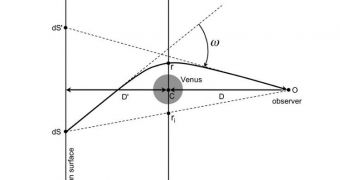Between June 5-6, 2012, the planet Venus will transit the Sun, providing astronomers with an amazing opportunity to study multiple aspects of its atmosphere, as well as other properties. This is the last time such a transit will occur during this century.
The next two instances when Venus passes directly between the Sun and Earth will occur in December 2117 and December 2125. As such, it's perfectly understandable why scientists are already preparing for an observations session that will occur three months from now.
The Europlanet Research Infrastructure and the EGIDE/PHC Sakura Program recently financed a workshop held at the Observatoire de Paris, in France. Researchers gathered at the meeting analyzed the best ways to go about extracting the most scientific data from this transit.
During the June event, astronomers plan to use Venus' movements as a proxy for detecting exoplanets orbiting distant stars. While the transit method is well established in observatories such as the NASA Kepler Telescope, it has yet to be used for other applications.
Scientists hope to be able to refine this observations method in such a way that it will become able to detect the dynamics, structure and composition of alien worlds from a great distance. The NASA James Webb Space Telescope is expected to be sensitive enough to do this, when it launches in 2018.
The second main objective will be to analyze the atmosphere around Venus from Earth's surface, as well as its orbit. Researchers are especially interested in the complex middle layer of the atmosphere, which they believe is key to understanding the complex weather phenomena occurring on Venus.
“This transit of Venus will be the last of our lifetime and will give a unique opportunity to closely observe an Earth-like planet passing in front of a Sun-like star,” explains workshop co-organizer and Observatoire de Paris astronomer, Dr. Thomas Widemann.
“Corot, Kepler have confronted us with the discoveries of more and more super-earth sized planets. Venus and Earth are sister planets, yet Venus evolved in a dramatic, different way,” he adds, quoted by AlphaGalileo.
“If Venus were an extrasolar transiting planet, what would we learn about its physical characteristics? What would we miss or misinterpret? We will use Venus transit observations to characterize the spectral signature of Venus, and test the detection limits of gases in the atmosphere,” he concludes.

 14 DAY TRIAL //
14 DAY TRIAL //